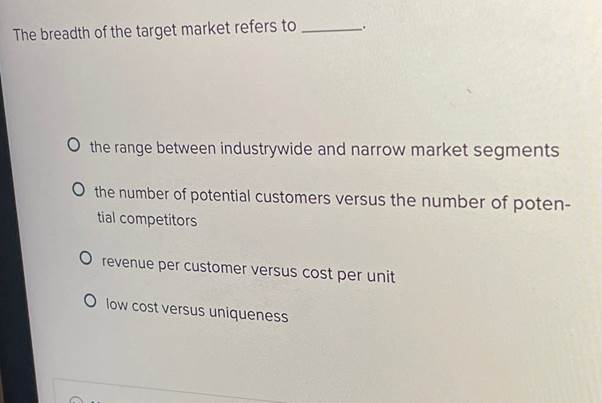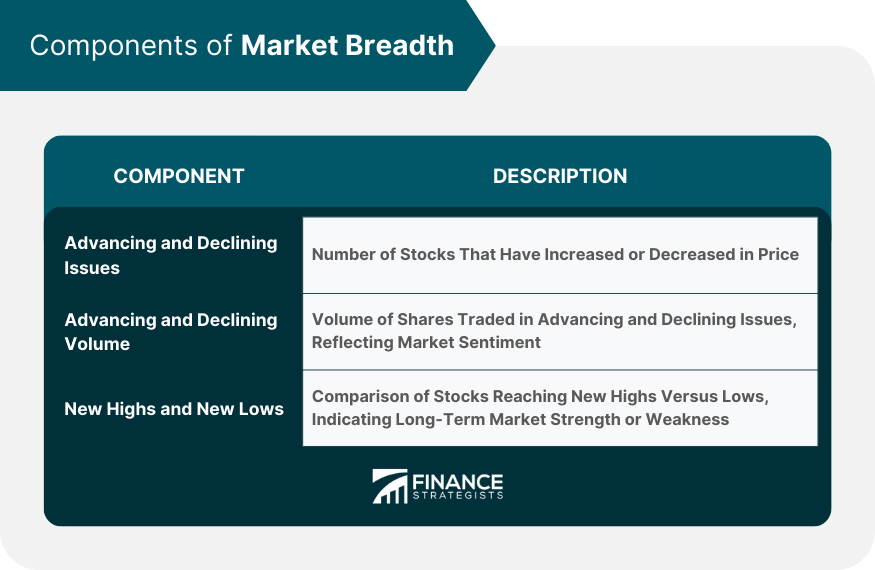The Breadth Of The Target Market Refers To

The phrase "breadth of the target market" is increasingly becoming a key concept for businesses and organizations across diverse sectors. It signifies the range and variety of consumers or individuals a product, service, or campaign aims to reach.
Understanding this breadth is crucial for effective marketing, product development, and overall strategic planning. The concept has far-reaching implications for how companies tailor their offerings and messaging to resonate with different groups.
What is the Breadth of the Target Market?
At its core, the breadth of the target market refers to the diversity of the individuals or entities a business aims to serve. It encompasses factors like demographics, psychographics, geographic location, and behavioral patterns.
A narrow target market might focus on a specific age group within a single city, while a broad target market could encompass multiple generations across several continents. The wider the range, the greater the breadth of the target market.
The term is often used in marketing, advertising, and product development to characterize the scope of potential customers.
Significance in Today's Market
In an increasingly globalized and interconnected world, understanding the breadth of the target market is more important than ever. Technological advancements and evolving social norms have created a more diverse consumer base.
Companies can no longer afford to adopt a one-size-fits-all approach. To succeed, businesses need to tailor their strategies to resonate with different segments of their target audience.
According to a 2023 report by Deloitte, companies that effectively leverage data analytics to understand their customer base and personalize their marketing efforts experience a 20% increase in sales conversion rates. This highlights the direct correlation between understanding target market breadth and business performance.
Key Factors Influencing Target Market Breadth
Several factors influence the breadth of a target market. These can range from the nature of the product or service to the overall marketing strategy of the company.
Product/Service Type
The type of product or service naturally impacts the potential customer base. A specialized industrial component, for instance, will have a narrower target market compared to a consumer product like a smartphone.
Businesses selling niche products might intentionally focus on a smaller, more defined target audience. Businesses selling everyday commodities would have a broader approach.
Marketing Strategy
A company’s marketing strategy plays a crucial role in determining the breadth of its target market. Mass marketing campaigns aim to reach a broad audience, while targeted marketing focuses on specific segments.
Companies might choose a broad approach to increase overall brand awareness or a targeted approach to maximize conversion rates within a specific demographic. The marketing strategy directly shapes the intended scope of the customer base.
Geographic Reach
The geographic reach of a business significantly influences the breadth of its target market. Local businesses cater to a smaller geographic area, while multinational corporations target consumers across multiple countries.
Expanding into new markets often involves adapting products and marketing messages to suit local cultures and preferences, further emphasizing the need to understand target market breadth.
Examples in Different Industries
The application of target market breadth varies significantly across different industries.
In the technology sector, Apple products like the iPhone are designed to appeal to a broad demographic, spanning age groups, income levels, and technological literacy. Their marketing strategy focuses on lifestyle integration and user-friendliness to attract a wide audience.
Conversely, a specialized software company providing solutions for the aerospace industry targets a very specific, niche market consisting of engineers and industry professionals.
In the food industry, companies like Coca-Cola aim to appeal to a global audience with universally appealing flavors and brand recognition. Smaller, artisanal food producers, on the other hand, may focus on local consumers seeking unique and regional products.
Potential Impact and Considerations
Understanding the breadth of the target market can lead to significant benefits, including increased sales, improved brand loyalty, and enhanced marketing effectiveness. However, it also presents challenges.
Broad target markets require substantial investment in marketing and distribution channels. They also necessitate careful consideration of cultural nuances and regional differences to ensure messaging is appropriate and effective.
Businesses must also be mindful of the potential for diluted messaging when trying to appeal to a wide audience. Balancing reach with relevance is key to successfully navigating the complexities of a broad target market.
Conclusion
The breadth of the target market is a fundamental concept in modern business strategy. As markets become increasingly diverse and interconnected, understanding the scope and variety of potential customers is essential for success.
By carefully considering factors like product type, marketing strategy, and geographic reach, businesses can effectively tailor their efforts to resonate with the desired audience, ultimately driving growth and enhancing competitiveness. This understanding will only continue to grow in importance as the global marketplace evolves.




.jpg)













